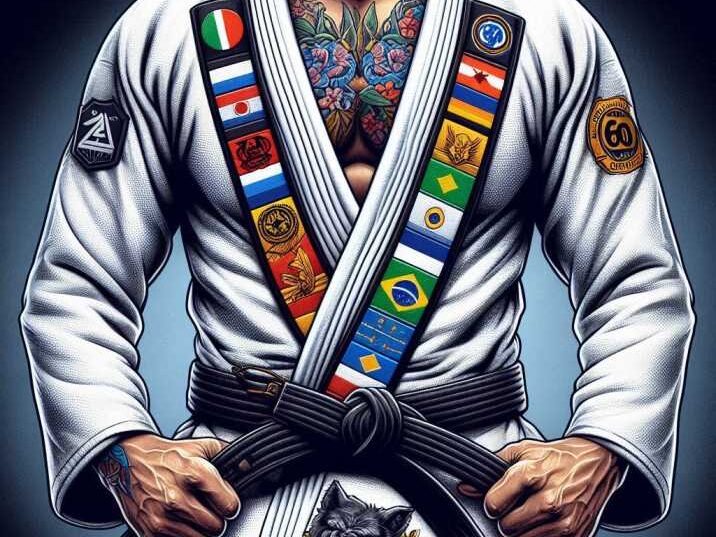Introduction
Table of Contents
Brazilian Jiu-Jitsu (BJJ) is a widely respected martial art, known for its focus on ground fighting, leverage, and technique. In mastering this art, belt ranks play a crucial role, signifying a practitioner’s growth in skill, experience, and understanding. Among these ranks, the purple belt stands out as a key milestone. It marks the transition from a beginner to an advanced intermediate level. Achieving the Brazilian Jiu-Jitsu purple belt not only requires technical expertise but also immense discipline, mental growth, and perseverance.

This article will dive deep into what it takes to earn a purple belt, the skills and techniques it demands, and how training can benefit young students by improving focus, discipline, and problem-solving skills. Whether you are new to BJJ or aiming for the purple belt, this guide is designed to provide helpful insights while being easy to understand for younger readers.
What is a Brazilian Jiu-Jitsu Purple Belt?
The purple belt is the third rank in the traditional Brazilian Jiu-Jitsu belt system, following the white and blue belts. It signifies a practitioner’s shift from mastering basic techniques to understanding more advanced submissions, escapes, and guard passes. A purple belt student have spent years on the mat, typically between 4 to 6 years of dedicated training, and is beginning to develop their unique style and approach to Jiu Jitsu.
At this level, purple belts can usually teach and assist lower-ranked students. Their understanding of the art allows them to explain complex techniques, lead drills, and offer advice during sparring sessions. However, they are still growing, working towards refining their skills to progress to the brown and eventually the coveted black belt.
How Long Does It Take to Achieve a Purple Belt?
The journey to a Brazilian Jiu-Jitsu purple belt is long and challenging. It requires consistent effort and regular practice. On average, it takes 4 to 6 years of focused training, but the timeline can vary depending on how often someone trains and how quickly they grasp the material.
Key factors that affect the journey to a purple belt include:
- Consistency in training (3-4 times a week)
- Mastery of fundamental and intermediate techniques
- Participation in live sparring (rolling) sessions
- Mentally embracing the principles of Jiu-Jitsu
The purple belt is a symbol of commitment and determination, and earning it requires physical and mental dedication.
Key Skills Every Brazilian Jiu-Jitsu Purple Belt Should Master
To reach the purple belt level, students must demonstrate proficiency in several key areas of Brazilian Jiu-Jitsu. At this stage, practitioners should not only know the basic moves but also apply them effectively during sparring and competition.
1. Advanced Guard Passing
Guard passing is a crucial skill for any purple belt. At this level, you should be able to pass an opponent’s guard with precision and control. Whether it’s the closed guard, half guard, or butterfly guard, knowing multiple ways to pass and maintain a strong position is vital.
2. Mastering Sweeps
Sweeps are techniques used to reverse the position on the ground, moving from a defensive position to an offensive one. A purple belt must have a variety of sweeps in its arsenal, such as the scissor sweep or flower sweep, to gain dominant positions.
3. Submissions
The ability to submit an opponent is central to Brazilian Jiu-Jitsu. A purple belt practitioner should be well-versed in classic submissions such as the triangle choke, armbar, and rear naked choke, and know when and how to apply them in different situations.
4. Positional Escapes
Knowing how to escape bad positions is as important as executing submissions. At the purple belt level, you must be comfortable escaping from dominant positions like mount, side control, and back control. Escapes such as the hip escape and bridge escape should be second nature by this time.
5. Takedowns
Mental and Emotional Growth at the Purple Belt Level
While Jiu-Jitsu is known for its ground game, understanding basic takedowns is essential for controlling a match from the start. Techniques like the double-leg takedown or single-leg takedown are valuable for any purple belt.
Beyond technical skills, the purple belt is a time of immense mental and emotional growth for Jiu-Jitsu practitioners. Students at this level develop:
- Confidence in their abilities to teach and lead newer students.
- Humility, as they realize there is always more to learn.
- Patience, since progress can slow down, and every plateau is an opportunity for reflection and refinement.
- Problem-solving abilities, as each sparring session presents new challenges that require creative solutions.
Purple belts often become role models within the gym, helping beginners while continuing to evolve their understanding of Brazilian Jiu-Jitsu.
How Brazilian Jiu-Jitsu Helps Improve Focus and Discipline
Training for a Brazilian Jiu-Jitsu purple belt requires deep focus, discipline, and the ability to problem-solve in real-time. These skills translate into improvements outside the gym, especially for young students.
1. Focus in School
During Jiu-Jitsu training, students must concentrate on every detail—where to place their hands, how to position their hips, and when to execute a move. This level of concentration helps improve their focus in school, making them more attentive in the classroom.
2. Improved Discipline
Jiu Jitsu demands consistent training, respect for instructors, and perseverance through tough times. These habits help students become more disciplined in schoolwork, staying on top of assignments and managing their time effectively.
3. Enhanced Problem-Solving Skills
Each sparring session presents challenges that students must solve. This practice of thinking on their feet helps develop critical thinking and problem-solving skills that can be useful in academics and everyday life.
Table of Information: Brazilian Jiu-Jitsu Belt Ranks
| Belt Color | Experience Level | Time to Achieve (Years) | Key Skills Focus |
|---|---|---|---|
| White | Beginner | 0-1 | Basic techniques, learning survival |
| Blue | Intermediate | 1-3 | Guard passes, submissions, positional control |
| Purple | Advanced Intermediate | 4-6 | Advanced techniques, sweeps, teaching others |
| Brown | Advanced | 6-8 | Mastering techniques, preparing for black belt |
| Black | Expert | 8+ | Teaching mastery, advanced strategy |

Conclusion
Achieving a Brazilian Jiu-Jitsu purple belt is a milestone that reflects years of hard work, both on the mats and in personal growth. With advanced techniques and a greater understanding of the art, purple belts are leaders within the gym and continue to evolve their skills. For students, the discipline and focus gained through training will benefit them in many areas of life, especially in academics and personal development.
FAQs about Brazilian Jiu-Jitsu Purple Belt
- How long does it take to get a Brazilian Jiu-Jitsu purple belt?
It usually takes around 4 to 6 years of consistent training to earn a purple belt. - Can a purple belt teach other students?
Yes, purple belts often assist in teaching beginners and lower belts, as they have a solid grasp of the fundamentals. - Is a purple belt considered advanced in Jiu-Jitsu?
Yes, a purple belt represents an advanced intermediate level, indicating a deep understanding of the art. - What is the hardest part of reaching the purple belt?
Staying consistent through the ups and downs of training and pushing through plateaus is often the toughest challenge. - What’s next after the purple belt?
The next rank after purple is the brown belt, followed by the black belt, which is the highest level in Brazilian Jiu-Jitsu.


